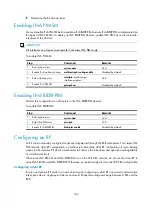
314
Step
Command
Remarks
5.
Enter system view.
system-view
N/A
6.
Enter interface view.
interface
interface-type
interface-number
N/A
7.
Enable the state-refresh
capability.
pim ipv6 state-refresh-capable
Optional.
Enabled by default.
Configuring state-refresh parameters
The router directly connected with the multicast source periodically sends state-refresh messages. You can
configure the interval for sending such messages.
A router might receive multiple state-refresh messages within a short time. Some messages might be
duplicated messages. To keep a router from receiving such duplicated messages, you can configure the
time that the router must wait before receiving the next state-refresh message. If the router receives a new
state-refresh message within the waiting time, it discards it. If this timer times out, the router will accept
a new state-refresh message, refresh its own IPv6 PIM-DM state, and reset the waiting timer.
The hop limit value of a state-refresh message decrements by 1 whenever it passes a router before it is
forwarded to the downstream node until the hop limit value comes down to 0. In a small network, a
state-refresh message might cycle in the network. To control the propagation scope of state-refresh
messages, you must configure an appropriate hop limit value based on the network size.
Perform the following configurations on all routers in the IPv6 PIM domain.
To configure state-refresh parameters:
Step
Command
Remarks
1.
Enter system view.
system-view
N/A
2.
Enter IPv6 PIM view.
pim ipv6
N/A
3.
Configure the interval
between state-refresh
messages.
state-refresh-interval
interval
Optional.
60 seconds by default.
4.
Configure the time to wait
before receiving a new
state-refresh message.
state-refresh-rate-limit
interval
Optional.
30 seconds by default.
5.
Configure the hop limit value
of state-refresh messages.
state-refresh-hoplimit
hoplimit-value
Optional.
255 by default.
Configuring IPv6 PIM-DM graft retry period
In IPv6 PIM-DM, graft is the only type of message that uses the acknowledgment mechanism. In an IPv6
PIM-DM domain, if a router does not receive a graft-ack message from the upstream router within the
specified time after it sends a graft message, the router keeps sending new graft messages at a
configurable interval (namely, graft retry period) until it receives a graft-ack message from the upstream
router.
For more information about the configuration of other timers in IPv6 PIM-DM, see "
















































